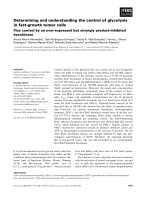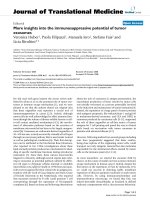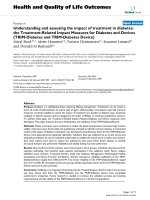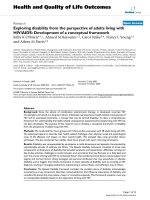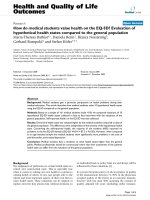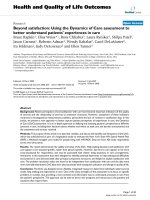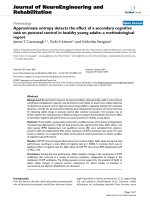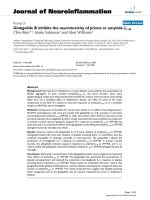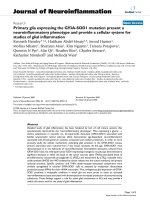báo cáo hóa học:" Response shift masks the treatment impact on patient reported outcomes (PROs): the example of individual quality of life in edentulous patients" pdf
Bạn đang xem bản rút gọn của tài liệu. Xem và tải ngay bản đầy đủ của tài liệu tại đây (267.74 KB, 8 trang )
BioMed Central
Page 1 of 8
(page number not for citation purposes)
Health and Quality of Life Outcomes
Open Access
Research
Response shift masks the treatment impact on patient reported
outcomes (PROs): the example of individual quality of life in
edentulous patients
Lena Ring*
1,2
, Stefan Höfer
1,3
, Frank Heuston
4
, David Harris
5
and
Ciaran A O'Boyle
1
Address:
1
Department of Psychology, Royal College of Surgeons in Ireland, Mercer Street Lower, Dublin 2, Ireland,
2
Dept of Pharmacy, BMC, Box
580, 751 23 Uppsala, Sweden,
3
Department of Medical Psychology and Psychotherapy, Medical University Innsbruck, Innsbruck, Austria,
4
Department of Restorative Dentistry & Periodontology, Dublin Dental Hospital, Dublin 2, Ireland and
5
The School of Dental Sciences, Trinity
College, Dublin 2, Ireland
Email: Lena Ring* - ; Stefan Höfer - ; Frank Heuston - ;
David Harris - ; Ciaran A O'Boyle -
* Corresponding author
Abstract
Background: Quality of life (QoL) is now established as an important outcome for evaluating the impact of disease, and
for assessing the efficacy of treatments. However, individuals change with time and the basis on which they make a QoL
judgement may also change, a phenomenon increasingly referred to as response shift. Here, the individual may change
his or her internal standards, values, and/or conceptualization on the target construct as a result of external factors such
as a treatment or a change in health status. This has important implications for assessing the effects of treatments as a
change in QoL may reflect a response shift, a treatment effect, or a complex combination of both. In this study, we used
an individualised quality of life (IQoL) measure, the SEIQoL, together with a then-test to determine whether response
shift would influence the measurement of treatment efficacy in edentulous patients.
Methods: Data are reported here for the first phase of a randomised controlled clinical trial designed to assess the
impact, on IQoL, of implant supported dentures compared with high quality conventional dentures. IQoL was measured
using the SEIQoL-DW in 117 patients (mean age 64.8; 32% male) at baseline (T
1
) and 3 months (T
2
) after receiving high
quality conventional dentures. The work was carried out in dental teaching hospitals in Dublin and Belfast.
Results: Unadjusted SEIQoL index scores revealed no significant impact of treatment at three months (baseline: 75.0; 3
months: 73.2, p = .33, n.s.). However, the then-test at 3 months revealed that patients retrospectively rated their baseline
IQoL as significantly lower (P < .001) than they had rated it at the time (then-test baseline: 69.2). Comparison of the 3
month scores with this readjusted baseline indicated a significant treatment effect (then-test baseline: 69.2; 3 months:
73.2, p = 0.016). 81% of patients nominated at least one different IQoL domain at 3 months.
Conclusion: The positive impact of denture treatment for edentulous patients on IQoL was seen only when response
shifts were taken into consideration. The nature of the response shifts was highly complex but the data indicated a degree
of re-conceptualisation and reprioritisation. Assessment of the impact of treatments using patient-generated reports
must take account of the adaptive nature of patients.
Published: 07 September 2005
Health and Quality of Life Outcomes 2005, 3:55 doi:10.1186/1477-7525-3-55
Received: 11 March 2005
Accepted: 07 September 2005
This article is available from: />© 2005 Ring et al; licensee BioMed Central Ltd.
This is an Open Access article distributed under the terms of the Creative Commons Attribution License ( />),
which permits unrestricted use, distribution, and reproduction in any medium, provided the original work is properly cited.
Health and Quality of Life Outcomes 2005, 3:55 />Page 2 of 8
(page number not for citation purposes)
"I know who I was when I got up this morning, but I've changed
several times since then." (Alice in Wonderland by Lewis
Carroll)
Background
Patient reported outcomes (PROs) are widely used in clin-
ical trials to incorporate patients' perspectives, and as
adjuncts to "harder" measures of morbidity and mortality
[1]. While PROs have long been considered simple, valid
and reliable measures of outcome, it is increasingly clear
that the cognitive processes involved in completing them
are complex [2]. Recently attention has been drawn to
potentially highly significant phenomena known as
response shift [3]. As human beings, we actively construct
meaning from our environment, and display a range of
cognitive mechanisms to continually adapt to changing
circumstances. Response shift refers to a change in the
meaning of one's evaluation a construct as a result of a
change in one's internal standards of measurement, a
change in one's values, or a change in one's definition of
the construct [3]. This means that persons might give dif-
ferent answers on PRO measures over time, not only
because their health or quality of life (QoL) has changed,
but also because they might have changed their percep-
tion on what health or QoL means to them. This may be
particularly important in repeated measures trials where
efficacy is measured as the change from a pre-treatment
baseline following treatment.
QoL is highly individual with patients varying considera-
bly in what they consider important for their QoL. It is
also know that the elements of QoL change over time and
in response to changing circumstances [4]. Individualised
measures of QoL (IQoL) increase respondents' discretion
in selecting the domains most important to their QoL
and, in determining the relative importance of these
domains. While it is feasible to use IQoL measures [4],
they are not yet widely used in clinical trials [5]. IQoL
measures such as the Patient Generated Index (PGI) [6]
and the Schedule for Evaluation of Individual Quality of
Life (SEIQoL) [7] may prove useful in determining the
impact of response shift on the assessment of treatment
effects in clinical trials.
The present study was designed to evaluate response shift
in edentulous patients undergoing treatment. This is a
chronic dental condition defined as total tooth loss and
which can have a significant impact on QoL. Patients seek
treatment for aesthetic reasons and to restore their oral
function. Whereas biological outcome measures such as
pocket depth, bone loss and chewing ability are important
in this patient group, there is an increasing emphasis on
the use of satisfaction and QoL measures to assess the
impact of treatment [8]. Previous research has shown low
correlations between patients' evaluations of their pros-
theses and clinicians' biological assessments [9].
Modern approaches to treatment involve replacing con-
ventional dentures with dentures supported by osseointe-
grated implants set into the bone. Improvements in oral
health following implants are well documented [10] and
implant-supported dentures are considered superior to
conventional dentures, since they are experienced as a part
of the patient's own body and allow patients to feel food
textures. Implants are more expensive than conventional
dentures and the treatment is also somewhat more cum-
bersome since it involves dental surgery to attach the
implants. Few longitudinal studies have used QoL as an
outcome to compare implants and conventional dentures
[8]. This study was designed as a randomised clinical trial
comparing treatment with implants with high quality
conventional dentures with QoL as the main outcome
measure. Data are reported here only for the first phase of
the study in which all patients wore new high quality (best
possible) conventional dentures for three months before
being randomised either to continue with the conven-
tional dentures or to receive implants. The fitting of excel-
lent dentures was done to ensure a proper baseline for the
clinical trial since many edentulous patients report prob-
lems with ill-fitting dentures. This is the first longitudinal
study to use the IQoL measure SEIQoL-DW [11] in this
patient group.
We hypothesised that fitting high quality dentures or
osseointegrated implants was likely to result in improved
eating, communication, appearance and social life [12]
and that consequently there should be a significant
improvement in individual IQoL. Since the treatment
periods were long (three months and six months), the
psychological impact of treatment was likely to be marked
on the main outcome measure individualised QoL. There-
fore we decided to attempt to measure response shifts,
since should these occur, they would complicate the inter-
pretation of the IQoL data.
Methods
Data presented here were collected as part of a larger ran-
domised controlled clinical trial comparing conventional
dentures with osseointegrated implant supported den-
tures in edentulous patients. The Ethics committees of the
respective dental teaching hospitals in Dublin and Belfast
granted ethical approval. Eligible patients were recruited
from waiting lists and from dental practices. Patients,
identified by consecutive sampling, were invited to partic-
ipate until the planned sample size of 70 patients per cen-
tre was reached. Patients had to have been edentulous for
at least two years, be under 75 years of age, be medically
suitable for surgery, be either non-smokers or smoking
fewer than 10 cigarettes per day, have bone height at the
Health and Quality of Life Outcomes 2005, 3:55 />Page 3 of 8
(page number not for citation purposes)
anterior mandible on radiographic assessment of at least
1 cm, have the cognitive ability to understand the purpose
of the study, and they had to provide informed consent.
All patients were fitted with the highest possible quality
conventional dentures at baseline and they wore these for
three months before being randomly assigned either to
continue with the conventional dentures or to receive
implant supported dentures. This was designed to estab-
lish a clinically acceptable baseline treatment to assess the
added value, if any, of implant supported dentures.
Individualised quality of life (IQoL)
IQoL was measured using the Schedule for the Evaluation
of Individual Quality of Life – Direct Weighting (SEIQoL-
DW) [11]. Respondents were first asked to nominate and
describe the 5 areas of their lives (cues) that they consider
to be the most important for their QOL. They were then
asked to rate their current level of satisfaction/functioning
on each cue on a scale between worst possible and best
possible. Finally, they were requested to allocate 100
points to indicate the relative importance of each cue by
using a pie-chart disc. The SEIQOL Index summary score,
was derived by multiplying each cue's weight by its corre-
sponding level, and summing the products across the 5
cues. The SEIQOL Index score ranged from 0 – 100, where
a higher score indicates better QoL.
Response shift
The SEIQOL allows patients to nominate different cues at
each assessment. It was assumed that, patients who nom-
inated different cues as being important to their QoL at 3
months has changed their concept of what constituted
QoL for them. This may reflect what Schwarz and Sprang-
ers refer to as re-conceptualization (Table 1).
In addition to assessing re-conceptualization in the form
of different cue nominations, we also wanted to deter-
mine whether other types of response shift might occur
which could impact on the assessment of the treatment.
Treatment effects are usually determined by assessing
changes in scores from a pre-treatment baseline. It is
assumed that a change represents a treatment effect. How-
ever, if a respondent shows a response shift by changing
the manner in which he or she completes the measure,
this may confound interpretation of the treatment effect.
The then-test has been proposed as a method that allows
some aspects of this process to be assessed [13]. The
patient is asked at T
2
retrospectively to rate their situation
at T
1
, not as they recall it, but as they now see it. The theory
is that they should be using the same internal criteria for
rating T
1
as they are now using for rating T
2
. Differences
between the original T
1
rating and the retrospective T
1
rat-
ing indicate response shift. If such differences are found,
the difference between the retrospective T
1
score and the
T
2
score is a more accurate indication of the treatment
effect since it controls for the response shift. For example,
a patient rates her pre-treatment level of pain as 7 on a 10-
point pain scale. She subsequently rates her post-treat-
ment level of pain as 3. This is taken to indicate that the
treatment has caused an improvement of 4 points. How-
ever, if she retrospectively rates her pre-treatment pain as
having been a 5, the actual treatment effect is 2. Likewise,
if she retrospectively rates her pre-treatment pain as hav-
ing been 10, the actual treatment effect is 7. The theory
proposes that she is using the same internal standard to
make the retrospective assessment as she is using to make
the current assessment. It can be seen from this example
that a response shift in a PRO may cause one to overesti-
mate or underestimate the real effect of a treatment if one
is basing the judgement solely on changes in raw scores.
We used the then-test at three months by asking patients
to rate retrospectively their original cues at baseline. They
were asked to re-rate cue levels (re-calibration) and cue
weights (re-prioritisation). The hypothesised components
of response shift measured in this way are shown in Table
1. The then-test was administered using the following
wording:
"You have shown me how your quality of life is at the moment.
The five important life areas that you have spoken about today
are the same five areas that you chose when we first met
1
. I
Table 1: SEIQoL-DW components of response shift
Response shift Description SEIQoL-DW indication
Re-conceptualisation Change in one's definition of the target construct Changes in nomination of cues (life areas) when comparing
pre- and post-test cue nominations.
Re-calibration Change in one's internal standards of measurement Changes in cue (life area) levels when comparing the pre-
test and then-test scores
Changes in SEIQoL Index scores when comparing pre-test
and then-test scores
Re-prioritisation Change in one's values Change in cue (life area) weights when comparing the pre-
and then-test scores
Health and Quality of Life Outcomes 2005, 3:55 />Page 4 of 8
(page number not for citation purposes)
would like you to show me how you now think you were doing
in each of these five life areas when we first met, by using this
same scale that we used earlier. I am not asking you to try and
remember how these important life areas were functioning, but
rather how, when looking back today, you now think they were
functioning when we first met."
Where patients had selected different cues at T
2
they were
asked in the then-test to retrospectively rate the cues orig-
inally chosen at T
1
.
The following wording were used to assess re-prioritisa-
tion:
"Now I would like you to show me how important you now
think your five life areas were in relation to each other when we
first met. Once again, I am not asking you to try and remember
how important these life areas were in relation to each other,
but rather what, when looking back today, you now think was
their relative importance when we first met."
Three experienced dental nurses, trained in the SEIQoL
interview technique and using a standard protocol for
administration of the then-test, administered all
assessments.
Statistics
Data were described using frequency distributions. Paired
t-tests were used to assess changes from T
1
to T
2
. Differ-
ences at a specific time point between variables were
assessed by independent t-tests. P values of p < .05 were
considered significant.
Results
Complete data were available for 117 patients (83.6%) at
baseline (T
1
) and 3 months after (T
2
) receiving high qual-
ity conventional dentures. The mean age of the sample
was 64 ± 8 years and 32% were male. The aim was to
include 140 patients but the final sample consisted of 136
patients. Two patients died before follow-up, others
dropped out due to having cancer (n = 1), or due to hav-
ing sick or dying relatives (n = 2), or were withdrawn due
to denture/implant problems (n = 4) and some dropped
out without reason (n = 5). Of the 122 patients finally
included at T1, 117 completed all study measures at both
time points. None of the patients found it difficult to com-
plete SEIQoL.
Cues nominated
The most frequently (percent of patients, choosing the cat-
egory as cue 1 and 5) nominated cues were; Family/next
of kin (46%–4%) e.g., partner, brother, mother, children,
grandchildren; Health (34%–5%) e.g., stay healthy, being
fit, being alive, pain; Hobbies/recreation (2%–31%) e.g.,
sports, reading, dancing, golf; Social life (2%–8%) e.g.,
meeting up with friends, ill fitting dentures preventing
social life, embarrassed to eat and talk; and Religion/faith
(3%–11%) e.g., God is important in life, like to believe
there's something after life. Cues directly concerned with
dental function were less frequently nominated (5%–3%)
e.g., oral health, eating out, dentures, being able to eat/
talk properly and appearance.
Treatment effect
As shown in Figure 1, there was no significant change in
unadjusted SEIQoL-DW Index scores from baseline to 3
months following treatment (pre-test: 75.0; post-test:
73.2, p = .33). Baseline Index scores generated from retro-
spective assessments using the then-test were significantly
lower that the Index scores generated using the original
baseline data (original baseline: 75.0; then-test baseline:
69.2, p < .001). When Index scores at 3 months were com-
pared with the baseline scores generated using the then-
test, a significant improvement in IQoL following denture
treatment was found (then-test: 69.2; post-test: 73.2, p =
0.016).
Response shifts
Cues
81% of patients nominated at least one different cue at 3
months compared to baseline.
Cue levels
In the then-test, all patients were asked to retrospectively
rate their baseline cue levels and weights at 3 months even
if they had nominated new cues at the latter time. As
shown in Table 2, mean cue levels ranged from 76-73
(pre-test), 68–75 (post-test) and 68–70 (then-test) on the
scale from 0–100. In the then-test, patients significantly
changed their ratings of the cue levels of 4 of 5 cues, on
average, indicating a significant degree of re-calibration.
There was a significant change from baseline at 3 months
in level of the most important cue (the cue given the high-
est relative weight), when comparing post-test and then-
test scores. While the most important cue nominated at 3
months is not necessarily the same as that nominated at
baseline, the change in the average level of the most
important cue may reflect a significant treatment effect.
Cue weights
Mean cue weights (see Table 2) ranged from 12%–30%
(pre-test) and 14%–27% (post-test) and 14%–27% (then-
test). In the then-test (comparing pre-test and then-test
scores), patients significantly changed their weightings,
on average, for the most and least important cues. At 3
months, the weights assigned to the most and least impor-
tant cues were significantly different than those assigned
to the most and least important cues at baseline (Note: the
most important and least important cues nominated at 3
Health and Quality of Life Outcomes 2005, 3:55 />Page 5 of 8
(page number not for citation purposes)
months are not necessarily the same as those nominated
at baseline).
Discussion
The main focus of this paper is the significance of
response shifts for assessing treatment outcomes. Dispari-
ties between objective clinical measures and patients' sub-
jective assessments are common. Patients with the same
condition respond differently and even the same patient
can respond differently over time. QoL measures used cur-
rently in clinical research were not designed to account for
response shifts but are based on the assumption that peo-
ple respond consistently on measurement scales and also
that scales are directly comparable across individuals and
over time. The classical approach has been to consider
individual differences in response as sources of error.
However, Schwartz and Rapkin [14] have argued convinc-
ingly that individual differences in cognitive appraisal
processes should be viewed, not as sources of error in QoL
research but, rather, that these properties are intrinsic to
all QoL measurement.
In this study, we used an individualised measure of qual-
ity of life, the SEIQoL-DW, as we felt that, by focusing on
the unique choices of patients, we would be in a position
to detect more clearly any response shifts that might
occur. SEIQoL index scores did not reveal a significant
improvement in IQoL 3 months after receiving high qual-
ity conventional dentures. However, when the baseline
scores were derived based on the then-test, and when
SEIQoL Index scores at baseline (T
1
) and after three months (T
2
)Figure 1
SEIQoL Index scores at baseline (T
1
) and after three months (T
2
).
1
The traditional reported treatment effect = post-
test minus pre-test score
2
The response shift effect = pre-test minus then-test score
3
The actual treatment effect = post-
test minus then-test score
75
69
73
65
68
71
74
77
80
Baseline - T1 3 months - T2
Response
shift
Effect
2
(pre- then)
=6
P=0.001
Traditional
reported
treatment
effect
1
(pre-post)
=-2
P=0.33
Actual
treatment
Effect
3
(post-then)
=4
P=0.016
pre
pre
then
then
post
post
Health and Quality of Life Outcomes 2005, 3:55 />Page 6 of 8
(page number not for citation purposes)
comparing then-test and post-test estimates, a significant
improvement was seen. Response shifts had occurred in
that patients had changed their criteria for assessing their
quality of life from baseline to 3 months. It was only when
this change was factored into the analysis that the
improvement following treatment could be seen. The
changes in the SEIQoL were highly complex but it is pos-
sible to gain some insight into their nature by looking at
the various components of the measure i.e. cues, weights
and levels.
Four out of every 5 patients (81%) nominated at least one
different QoL cue at 3 months compared to baseline.
Therefore, the elements that they considered most impor-
tant for their quality of life changed over the study period.
This represents a form of re-conceptualisation, one with
which clinicians will be familiar. Patients change and
adapt with time and in response to changing circum-
stances. The domains that might have been important for
one's QoL before treatment may not be as important on a
subsequent occasion. The same phenomenon can be seen
with disease progression. Some patients with severe
chronic conditions report higher QoL than do healthy
individuals [15]. Significantly disabled or terminally ill
patients sometimes report QoL similar to or higher than
that of healthy controls [16]. One limitation of the
SEIQoL-DW in this context is that, the respondent is only
allowed to select 5 cues. If she chooses different cues on a
subsequent occasion from those chosen previously, it
could be argued (as we have done) that she has re-concep-
tualised what QoL means to her. But if she were allowed
select as many cues as she wished and she included all of
the cues previously chosen as well as any new ones, then
this would be more likely to indicate re-prioritisation
rather than re-conceptualization. Patients may also have
used different words at each evaluation to refer to essen-
tially the same area. This can be controlled by collecting
detailed descriptions of the life areas chosen as well as
including questions assessing patients' own perception of
change.
Patients were asked at 3 months to indicate retrospectively
their level of functioning on each of the cues chosen at
baseline. In general, patients retrospectively rated their
level of functioning on most of the cues as lower that they
had done at the time. If we assume that they completed
both assessments at 3 months using a single internal
frame of reference, it seems reasonable to label this as re-
calibration. It may be that the superior function associ-
ated with the quality dentures provided caused patients
retrospectively to perceive their pre-treatment levels as
worse on reflection.
Because the SEIQoL-DW weights are individualised, it is
possible to measure changes in the relative importance of
cues over time. We found that on average some weights
Table 2: Average cue levels and weights for each of the 5 SEIQOL-DW cues selected by respondents at baseline.
Cues* T
1
– pre-test mean
level ± SD.
mean weight ± SD.
T
2
– post test mean
level ± SD.
mean weight ± SD.
T
1
– then-test mean
level ± SD.
mean weight ± SD.
P-value Levels # P-value Weights #
1 pre-post: .359 pre-post: .026
level 73.8 ± 28.3 74.6 ± 22.3 69.7 ± 26.9 pre-then: .076 pre-then: .033
weight 29.6 ± 12.4 26.9 ± 9.2 26.7 ± 9.79 post-then: .005 post-then: .649
2 pre-post: .088 pre-post: .404
level 76.2 ± 24.1 71.1 ± 26.2 69.0 ± 24.7 pre-then : .003 pre-then .152
weight 23.3 ± 10.59 22.3 ± 9.47 21.8 ± 8.61 post-then: .106 post-then: .598
3 pre-post: .069 pre-post: .801
level 75.7 ± 27.1 70.8 ± 24.0 70.1 ± 24.7 pre-then: .006 pre-then: .534
weight 20.2 ± 9.91 20.6 ± 8.85 21.0 ± 8.97 post-then: .403 post-then: .808
4 pre-post: .269 pre-post: .223
level 72.7 ± 24.7 68.1 ± 26.4 67.9 ± 23.8 pre-then: .036 pre-then: .073
weight 15.0 ± 7.91 16.2 ± 8.27 16.6 ± 7.75 post-then:.424 post-then:.576
5 pre- post:.105 pre- post:.012
level 74.2 ± 22.6 69.5 ± 25.7 68.7 ± 23.9 pre-then: .028 pre-then:.015
weight 12.3 ± 6.05 14.2 ± 7.03 14.3 ± 6.50 post-then: .635 post-then: .777
* Cues in descending order of importance at T1
# The traditional reported treatment effect = post-test minus pre-test score
# The response shift effect = pre-test minus then-test score
# The actual treatment effect = post-test minus then-test score
Health and Quality of Life Outcomes 2005, 3:55 />Page 7 of 8
(page number not for citation purposes)
(comparing pre-test and then-test weights) changed indi-
cating that reprioritisation can occur. However, when
comparing then-test and post-test weights we found no
changes. This might be a true finding, or maybe patients
simply applied the same weights they were using at T2 to
the cues at T1. This may also partly be an artefact of the
SEIQoL-DW procedure as the weights of all five cues
selected by respondents are constrained to add to 100.
Therefore, if the relative importance of one cue increases,
the relative importance of at least one of the other four
cues must diminish.
One of the major challenges in interpreting the results of
this study is that 81% of the patients chose at least one dif-
ferent cue at 3 months compared to baseline. All patients
were asked, in the then-test, to re-evaluate their baseline
cues, whether they were the same or not. It seems likely
that this process is different for those who chose the same
and different cues at 3 months and this is worthy of fur-
ther research. The sample size of 19% of patients who
chose exactly the same cues at 3 months was too small to
draw firm conclusions about the nature of response shift
in this group.
Some studies have found that memory can influence the
findings from the then-test [17]. A limitation with our
study is that we did not control for recall bias and we did
not compare the changes with any criterion measure of
change [18,19]. However, receiving dentures is a signifi-
cant and salient event and it seems likely that the influ-
ence of recall bias is minimal especially given the number
of judgements a patient had to make and the 3 month gap
between assessments. One alternative explanations for
our findings of a discrepancy between prospective and ret-
rospective assessments is that subjects may have expected
that receiving high quality dentures should improve their
health, an they retrospectively rated their initial health as
lower to reflect this expectation, a cognitive mechanism
known as the implicit theory of change [20]. Our interpre-
tation of the results is based on the assumption that the
retrospective then-test data provides a more valid indica-
tion of baseline IQoL for comparison with 3 month data
than does the baseline assessment itself. If, however we
assume that the retrospective judgement is biased and that
the concurrent baseline assessment is more valid, our
results would be interpreted differently and there would
be no treatment effect. To support the response shift the-
ory, we would need to show that the new information
available to patients after receiving their dentures led to
more valid judgments of their baseline scores. However, it
is as yet unclear how one would determine which theory
is more valid for a particular situation. It would be impor-
tant to distinguish patients who's situation had improved
or deteriorated from those who had changed their mind
about what it means to have the best or worst possible
outcome.
Recently, Schwartz and Rapkin have proposed a new psy-
chometric model, which posits that the "true" PRO score
is contingent on aspects of the appraisal process [14]. The
appraisal of a construct like QoL may be related to culture,
personality and situation and may vary across persons and
over time [21-24]. Building on the response shift model,
Schwartz and Rapkin have proposed using an Appraisal
Profile [21]. They suggest that "rather than simply asking
people to re-rate their baseline status using "today's crite-
ria", we assess their appraisal processes to make those cri-
teria explicit at each time in order to help characterise
qualitative change". Improved knowledge about the ways
in which patients appraise QoL might lead to more valid,
reliable and responsive measures. Future studies need to
disentangle the differing ways individuals appraise QoL
and researchers must acknowledge the dynamic nature of
QoL by empirically testing for response shift phenomena.
Conclusion
Improvements in the IQoL in edentulous patients, follow-
ing treatment with high quality dentures, were apparent
only when patient adaptation over time, was taken into
account. This study demonstrated that an IQoL measure
such as the SEIQoL-DW can be used to assess re-conceptu-
alisation and reprioritisation and can be applied as a then-
test to control for recalibration.
List of abbreviations
QoL quality of life
IQoL individualised quality of life
SEIQoL-DW Schedule for the Evaluation of Individualised
Quality of Life – Direct Weighting
PRO patient reported outcomes
Authors' contributions
CAO, DH and FH developed the core idea. CAO, DH and
FH designed the study. LR and SH monitored the study.
CAO, LR and SH conducted the literature search. SH and
LR performed the statistical analyses. LR wrote the first
draft of the paper. All authors critically reviewed and con-
tributed to the final draft of the paper and all are
guarantors.
Acknowledgements
This study was funded by Straumann Ltd, Switzerland. The founding source
had no involvement in either study design or in the collection, analysis and
interpretation of data or in the writing of the report and the decision to
submit the paper for publication.
Publish with BioMed Central and every
scientist can read your work free of charge
"BioMed Central will be the most significant development for
disseminating the results of biomedical research in our lifetime."
Sir Paul Nurse, Cancer Research UK
Your research papers will be:
available free of charge to the entire biomedical community
peer reviewed and published immediately upon acceptance
cited in PubMed and archived on PubMed Central
yours — you keep the copyright
Submit your manuscript here:
/>BioMedcentral
Health and Quality of Life Outcomes 2005, 3:55 />Page 8 of 8
(page number not for citation purposes)
This manuscript was completed while the authors Dr. Lena Ring and Dr.
Stefan Höfer were EU Marie Curie Research Fellows at the Department of
Psychology, Royal College of Surgeons in Ireland.
We also wish to acknowledge the Royal Victoria Hospital, School of Den-
tistry, Belfast for patient recruitment and dental nurses Rosaleen Glackin,
Sharon Kennedy and Janine Burns for performing the SEIQoL interviews.
Finally, a special acknowledgement to Sarah Clarke for assistance with initial
planning and setting up of the study.
References
1. Wiklund I: Assessment of patient-reported outcomes in clini-
cal trials: the example of health-related quality of life. Fundam
Clin Pharmacol 2004, 18:351-363.
2. McColl E, Meadows K, Barofsky I: Cognitive aspects of survey
methodology and quality of life assessment. Qual Life Res 2003,
12:217-218.
3. Sprangers MA, Schwartz CE: Integrating response shift into
health-related quality of life research: a theoretical model.
Soc Sci Med 1999, 48:1507-1515.
4. Joyce CRB, McGee HM, O'Boyle CA: Individual quality of life:
Approaches to conceptualisation and assessment Amsterdam, Harwood
Academic Publishers; 1999.
5. O'Boyle C, Höfer S, Ring L: Individualized Quality of Life. In
Assessing the quality of life in clinical trials 2nd edition. Edited by: Fayers
P and Hays RD. Oxford Oxford University Press; 2004:225-242.
6. Ruta DA, Garratt AM, Leng M, Russell IT, MacDonald LM: A new
approach to the measurement of quality of life. The Patient-
Generated Index. Med Care 1994, 32:1109-1126.
7. O'Boyle CA, McGee H, Hickey A, O'Malley K, Joyce CR: Individual
quality of life in patients undergoing hip replacement. Lancet
1992, 339:1088-1091.
8. Allen P: Assessment of oral health related quality of life.
Health Qual Life Outcomes 2003, 1:40. 8 September 2003
9. Feine JS, Awad MA, Lund JP: The impact of patient preference
on the design and interpretation of clinical trials. Community
Dent Oral Epidemiol 1998, 26:1-5.
10. Boerrigter E, Stegenga B, Raghoebar G, Boering G: Patient satisfac-
tion and chewing ability with implant retained mandibular
overdentures. Int J Oral Maxillofacial Surg 1996, 53:1167-1173.
11. Hickey AM, Bury G, O'Boyle CA, Bradley F, O'Kelly FD, Shannon W:
A new short form individual quality of life measure (SEIQoL-
DW): application in a cohort of individuals with HIV/AIDS.
BMJ 1996, 313:29-33.
12. Allen PF, McMillan AS: A review of the functional and psychoso-
cial outcomes of edentulousness treated with complete
replacement dentures. J Can Dent Assoc 2003, 69:662.
13. Sprangers MAG, van Dam FSAM, Broersen J, et al.: Revealing
response shift in longitudinal research on fatigue: The use of
the thentest approach. Acta Oncol 1999, 38:709-718.
14. Schwartz CE, Rapkin BD: Reconsidering the psychometrics of
quality of life assessment in light of response shift and
appraisal. Health and Quality of Life Outcome 2004, 2:16.
23(March2004)
15. Ubel PA, Loewenstein G, Jepson C: Whose quality of life? A com-
mentary exploring discrepancies between health state eval-
uations of patients and the general public. Qual Life Res 2003,
12:599-607.
16. Bach JR, Tilton MC: Life satisfaction and well-being measures in
ventilator assisted individuals with traumatic tetraplegia.
Arch Phys Med Rehabil 1994, 75:626-632.
17. Ahmed S, Mayo NE, Wood-Dauphinee S, Hanley JA, Cohen SR:
Response shift influenced estimates of change in health-
related quality of life poststroke. J Clin Epidemiol 2004,
57:561-570.
18. Schwartz CE, Sprangers MA: Methodological approaches for
assessing response shift in longitudinal health-related qual-
ity-of-life research. Soc Sci Med 1999, 48:1531-1548.
19. Schwartz CE, Sprangers MAG, Carey A, Reed G: Exploring
response shift in longitudinal data. Psychol Health 2004,
19:51-69.
20. Norman G: Hi! How are you? Response shift, implicit theories
and differing epistemologies. Qual Life Res 2003, 12:239-249.
21. Rapkin BD, Schwartz CE: Toward a theoretical model of qual-
ity-of-life appraisal: Implications of findings from studies of
response shift. Health and Quality of Life Outcome 2004, 2:14. 15
March 2004
22. Nisbett RE, Peng K, Choi I, Norenzayan A: Culture and systems of
thought: holistic versus analytic cognition. Psycol Rev 2001,
108:291-310.
23. Diener E, Oishi S, Lucas RE: Personality, culture, and subjective
well-being: emotional and cognitive evaluations of life. Annu
Rev Psychol 2003, 54:403-425.
24. Suh E, Diener E, Oishi S, Triandis HC: The shifting base of life sat-
isfaction judgements across cultures: emotions versus
norms. J Pers Soc Psychol 1998, 74:482-493.

